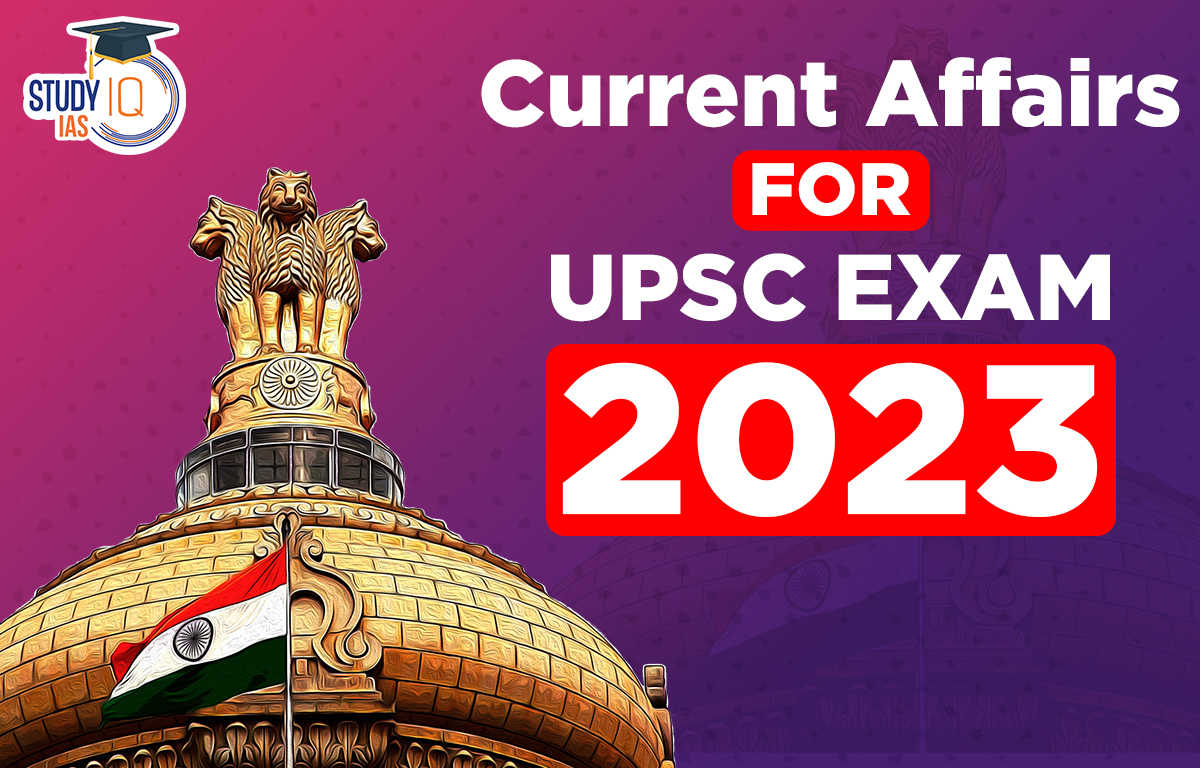Current Affairs 5th April 2023 for UPSC Prelims Exam
Sodium Cyanide
Context: India has initiated an anti-dumping probe into imports of poisonous chemical, sodium cyanide from China, European Union, Japan and Korea following a complaint by domestic players.
About Sodium Cyanide
- Sodium Cyanide is a toxic cyanide salt, sodium salt, and one-carbon compound that is used as an insecticide, a test reagent for the function of chemoreceptors, and in many industrial processes.
- It is characterized as a white crystalline solid, colourless gas, or aqueous solution that is odourless or has a faint, bitter almond-like odour. Exposure occurs by inhalation, ingestion, or contact.
- Production: It is produced by treating hydrogen cyanide with sodium hydroxide.
- Utility: Sodium cyanide is used for extraction of gold and silver from their respective ores, manufacturing insecticides, dyes, pigments, and bulk drugs.
About Anti-Dumping duties
- Dumping is when the goods are exported by a country to another country, at a price lower than the price it normally charges in its own home market.
- Anti-dumping duty is a measure to rectify impacts, arising out of the dumping of goods and its trade distortive effect. The Finance ministry takes the final decision to impose duties.
- The imposition of duties falls under the multilateral regime of World Trade Organization (WTO), which aims at ensuring fair trading practices and creating a level-playing field for domestic producers vis-a-vis foreign producers and exporters.
- Imposition: The Directorate General of Trade Remedies (DGTR) examines whether domestic industries have been harmed by an increase in cheap imports and, if so, will recommend the imposition of anti-dumping duty on the imports.
- Validity: Anti-dumping duty is valid for a period of five years from the date of imposition unless revoked earlier.
- It can be extended for a further period of five years through a sunset or expiry review investigation.
Current Affairs 4th April 2023 for UPSC Prelims Exam
Project 75 (I)
Context: Germany is expected to present a proposal to India for the sale of advanced conventional submarines through the government-to-government route.
About Project 75 (India) [P-75(I)]
- It is an ambitious plan for the indigenous construction of six modern conventional submarines with contemporary equipment, weapons & sensors including Fuel-Cell based AIP (Air Independent Propulsion Plant), advanced torpedoes, modern missiles and state of the art countermeasure systems.
AIP Module
- An AIP module acts as a force multiplier as it enables conventional submarines to remain submerged for a longer duration, thereby increasing their endurance and reducing chances of detection.
- An indigenously developed AIP module is set to be installed on the Scorpene submarines as they go for refit from 2024 onwards.
Significance of P-75 (I)
- P-75 (I) would provide a major boost to the indigenous design and construction capability of submarines in India.
- It would bring the latest submarine design and technologies as part of the project.
Project-75
- It includes the indigenous construction of six diesel-electric attack submarines of Scorpene design.
- The submarines are being constructed at Mazagon Dock Shipbuilders Limited (MDL) in Mumbai in collaboration with the Naval Group of France.

Asilomar Principles and Artificial General Intelligence (AGI)
Context: A group of AI experts have signed a letter of moratorium on developing advanced artificial intelligence (AI) systems, citing Asilomar AI Principles.
About Asilomar Principles
- Asilomar AI Principles are a set of 23 guidelines for the research and development of artificial intelligence (AI).
- They were laid out at the Beneficial AI 2017 conference hosted by Future of Life Institute (FLI).
- These principles were developed by a group of AI researchers, robotics, technology experts and legal scholars from different institutions.
Artificial General Intelligence (AGI)
- AGI refers to a theoretical type of machine intelligence that possesses human-like cognitive abilities. AGI is also known as deep AI, strong AI, full AI, or general intelligent action.
- AGI does not involve replicating or simulating processes, instead it focuses on training machines to understand humans to differentiate needs, emotions, beliefs, and thought processes.
- Concerns with AGI
- AGI poses serious risk of misuse, drastic accidents, and societal disruption. AGI can also threaten large number of jobs.

Avalanches
Context: Recently, a massive avalanche hit the Gangtok-Nathu La road near MS-15 (between Mile 13 and 17).
About Avalanches:
- Avalanches are masses of snow, ice, and rocks that fall rapidly down a mountainside.
- There are various kinds of avalanches, including rock avalanches (which consist of large segments of shattered rock), ice avalanches (which typically occur in the vicinity of a glacier), and debris avalanches (which contain a variety of unconsolidated materials, such as loose stones and soil).
- The size of an avalanche can range from a small shifting of loose snow to the displacement of enormous slabs of snow.
- In a slab avalanche, the mass of descending snow may reach a speed of 130 km (80 miles) per hour and is capable of destroying forests and small villages in its path.
- Some important types of Avalanches
- Slab avalanches: A slab avalanche occurs when the weak layer lies lower down in a snowpack.
- Loose snow avalanches: Loose snow avalanches happen when poorly bonded surface snow slides downhill under its own weight.
- Cornice Fall Avalanches: Cornices are overhanging masses of wind-deposited snow that protrude from sharp terrain features like ridges or peaks.
- Powder Snow Avalanches: Powder Snow Avalanches are a mix of the other forms, Loose Snow and Slab.
- Glide Avalanches: Glide occurs when the entire snowpack slowly slides as a unit on the ground, similar to a glacier.
- Slush Avalanches: slush avalanche occurs in impermeable permafrost soil, which allows water to pool up, and occurs during rapid saturation of a thin, weak snowpack.
- Causes of Avalanches: Heavy Snowfall, Wind Direction, Vibration or Movement, Layers of Snow, Steep Slopes, Warm Temperature, Deforestation, Natural Causes (i.e., Earthquakes), Human Activity.

Nathu La Pass:
- Nathu La is a mountain pass in the Himalayas connecting Sikkim with Chumbi Valley of the Tibetan Plateau in China.
- It is located ahead of Muguthang or Cho Lhamu (source of River Teesta).
- It is one of the three open trading border posts between China and India; the others being Shipki La in Himachal Pradesh and Lipulekh at the trisection point of Uttarakhand–India, Nepal and China.
- Nathu means ‘listening ears’, and La means ‘pass’.
- The other passes located in the state of Sikkim are Jelep La Pass, Donkia Pass, Chiwabhanjang Pass.

Open-Source Software (OSS)
Context: Owner and CEO of Twitter (Elon Musk) has partly delivered on his promise of making Twitter’s algorithm open source.
About Open-Source Software (OSS):
- OSS is software that is distributed with its source code, making it available for use, modification, and distribution with its original rights.
- Source code is the code computer programmers manipulate to control how a program or application behaves.
- OSS typically includes a license that allows programmers to modify the software to best fit their needs and control how the software can be distributed.
- The idea of making source code freely available originated in 1983 from an ideological movement informally founded by Richard Stallman, a programmer at MIT.
- Examples of Linux, Mozilla Firefox, VLC media player, SugarCRM, etc.
- Benefits of OSS:
- The Open-source model is based on a more decentralized model of production, thus helps in reducing the monopoly of large commercial firms which are primarily centralized model of production for revenue maximization.
- OSS will help in reducing government’s cost of procurement of commercial software’s.
- OSS can be modified and customized to suit spatial and temporal diversities.
Twitter’s Algorithm
- It is a set of rules that enables the platform to deliver content based on users’ interests and preferences.
- Content flows into a user’s timeline through two channels.
- One pipeline channels content posted by people that the user follows and the other is filled with posts flowing from accounts that could potentially interest the user.

Central Administrative Tribunal (CAT)
Context: Parliamentary committee on Personnel, Public Grievances, Law and Justice has asked CAT to decide cases pending for more than 10 years on a priority basis.
About Central Administrative Tribunal (CAT):
- CAT had been established (under Administrative Tribunal Act, 1985) under Article 323 -A for adjudication of disputes and complaints with respect to recruitment and conditions of service of persons appointed to public services and posts.
- Members of defence forces, officers and servants of Supreme Court and secretarial staff of Parliament are not covered by it.
- According to CAT (Procedure) Rules, 1987, every application should be heard and decided as far as possible, within six months from date of its registration.
- Objective and Composition: The CAT is a specialist body consisting of Administrative Members and Judicial Members who by virtue of their specialized knowledge are better equipped to dispense speedy and effective justice.
- A Chairman who has been a sitting or retired Judge of a High Court heads the CAT.
- The sanctioned strength of members in CAT is 70 (35 judicial members and 35 administrative members), including the chairman.
- Operating Principles:
- The Tribunal is guided by the principles of natural justice in deciding cases and is not bound by the procedure prescribed by the Civil Procedure Code.
- Under Section 17 of the Administrative Tribunal Act, 1985, the Tribunal has been conferred with the power to exercise the same jurisdiction and authority in respect of contempt of itself as a High Court.
- Independence:
- The conditions of service of the Chairman and Members are the same as applicable to a Judge of High Court as per the Administrative Tribunals (Amendment) Act, 2006.
- Appeals against Orders:
- The orders of the CAT are challenged by way of a Writ Petition under Article 226/227 of the Constitution before the respective High Court in whose territorial jurisdiction the Bench of the Tribunal is situated.


 AI Maker Labs: A Promise to build AI in ...
AI Maker Labs: A Promise to build AI in ...
 Daily Quiz 15 April 2025
Daily Quiz 15 April 2025
 How RBI Responded To Global Trade War Ch...
How RBI Responded To Global Trade War Ch...





















